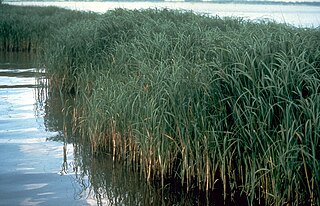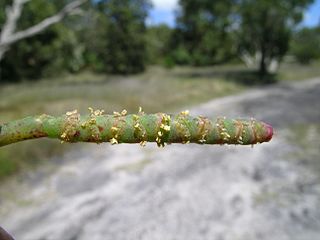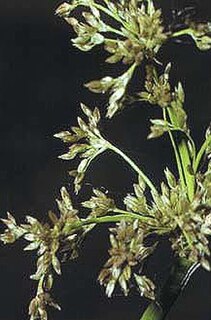
A halophyte is a salt-tolerant plant that grows in soil or waters of high salinity, coming into contact with saline water through its roots or by salt spray, such as in saline semi-deserts, mangrove swamps, marshes and sloughs and seashores. The word derives from Ancient Greek ἅλας (halas) 'salt' and φυτόν (phyton) 'plant'. An example of a halophyte is the salt marsh grass Spartina alterniflora. Relatively few plant species are halophytes—perhaps only 2% of all plant species.

A lagoon is a shallow body of water separated from a larger body of water by reefs, barrier islands, or a barrier peninsula. Lagoons are commonly divided into coastal lagoons and atoll lagoons. They have also been identified as occurring on mixed-sand and gravel coastlines. There is an overlap between bodies of water classified as coastal lagoons and bodies of water classified as estuaries. Lagoons are common coastal features around many parts of the world.

A salt marsh or saltmarsh, also known as a coastal salt marsh or a tidal marsh, is a coastal ecosystem in the upper coastal intertidal zone between land and open saltwater or brackish water that is regularly flooded by the tides. It is dominated by dense stands of salt-tolerant plants such as herbs, grasses, or low shrubs. These plants are terrestrial in origin and are essential to the stability of the salt marsh in trapping and binding sediments. Salt marshes play a large role in the aquatic food web and the delivery of nutrients to coastal waters. They also support terrestrial animals and provide coastal protection.

Araxos is a village and a community in the municipal unit of Larissos of the municipality West Achaea in the northwestern part of Achaea, Greece. The community consists of the villages Araxos, Akrotirio Araxos and Taxiarches. It is located in the coastal plains near Cape Araxos, which separates the Gulf of Patras from the Ionian Sea. There are two lagoons near the village Araxos: Prokopos to the southwest and Kalogria to the north. The Mavra Vouna hills are in the north, Cape Araxos being their northernmost point. It is 4 km west of Lakkopetra, 1 km west of Araxos Airport, 5 km north of Metochi and 13 km west of Kato Achaia.

The wildlife of Egypt is composed of the flora and fauna of this country in northeastern Africa and southwestern Asia, and is substantial and varied. Apart from the fertile Nile Valley, which bisects the country from south to north, the majority of Egypt's landscape is desert, with a few scattered oases. It has long coastlines on the Mediterranean Sea, the Gulf of Suez, the Gulf of Aqaba and the Red Sea. Each geographic region has a diversity of plants and animals each adapted to its own particular habitat.

Sarcocornia quinqueflora, commonly known as beaded samphire, bead weed, beaded glasswort or glasswort, is a species of succulent halophytic coastal shrub. It occurs in wetter coastal areas of Australia and New Zealand.

Nitraria retusa is a salt-tolerant and drought-resistant shrub located in the Nitrariaceae family. It can grow to heights of 2.5 metres, although it seldom exceeds more than 1 m in height. It produces small white/green coloured flowers and small edible red fruit. The plant is native to desert areas of northern Africa, where it grows in primary succession on barren sand dunes, and in areas with high salinities such as salt marshes.

Lake Bardawil is a large, very saline lagoon nearby the protected area of Zaranik in Egypt on the north coast of the Sinai Peninsula. Lake Bardawil is about 30 kilometers (19 mi) long, and 14 kilometers (8.7 mi) wide. It's considered to be one of the three major lakes of the Sinai Peninsula, along with the Great Bitter Lake and the Little Bitter Lake. It continues to decrease in size as sands move and is becoming more of a Playa or Sabkha than a lake. Between Port Said and Rafah are three main sabkhat which extend from west to east: Sabkhat El Malaha, Sabkhat Bardawil and Sabkhat El Sheikh Zawayed.

Juncus roemerianus is a species of flowering plant in the rush family known by the common names black rush, needlerush, and black needlerush. It is native to North America, where its main distribution lies along the coastline of the southeastern United States, including the Gulf Coast. It occurs from New Jersey to Texas, with outlying populations in Connecticut, New York, Mexico, and certain Caribbean islands.

Spartina cynosuroides is a species of grass known by the common names big cordgrass and salt reedgrass. It is native to the East Coast and Gulf Coast of the United States, where it grows in coastal habitat such as marshes, lagoons, and bays.

Suaeda fruticosa, commonly known as shrubby seablight, is a species of plant in the family Amaranthaceae. It is a small shrub, with very variable appearance over its wide range. It is a halophyte, and occurs in arid and semi-arid saltflats, salt marshes and similar habitats. It can be used for soil remediation to reduce salinity and contamination by toxic metals. The species is synonymous with Suaeda vermiculata Forssk. ex J.F.Gmel. and Suaeda vera Forssk. ex J.F.Gmel.

Borrichia frutescens is a North American species of flowering plants in the aster family known by the common names sea oxeye, sea oxeye daisy, bushy seaside tansy, and sea-marigold. In Veracruz it is called verdolaga de mar. It is native to the United States and Mexico, where it occurs along the Atlantic and Gulf Coasts. Its distribution extends from Maryland south to Florida and west to Texas in the US, and along the Mexican Gulf Coast to the Yucatán Peninsula. It is an introduced species in some areas, such as Bermuda and Spain.
Tetraena qatarensis is a salt-tolerant dwarf shrub that grows in the Arabian Peninsula. It has small compact leaves that store water. The leaflets grow in pairs and the flowers have four or five petals.
Salsola imbricata is a small species of shrub in the family Amaranthaceae. It grows in deserts and arid regions of north Africa, the Arabian Peninsula and southwestern Asia.

Tetraena alba is a species of plant in the family Zygophyllaceae which is found in arid regions of Africa and the Arabian Peninsula. It is a salt tolerant plant and dominates many of the plant communities in which it grows.
Juncus rigidus is a species of rush known by the common name sea rush. It is native to much of Africa and parts of western Asia. It is found inland and by the sea in sandy saline habitats.

Arthrocnemum macrostachyum is a species of flowering plant in the amaranth family. It is native to coastal areas of the Mediterranean Sea and the Red Sea and parts of the Middle East, where it grows in coastal and inland salt marshes, alkali flats, and other habitats with saline soils.

Aeluropus lagopoides, sometimes called mangrove grass or rabbit-foot aeluropus, is a species of Eurasian and African plant in the grass family, found primarily in salty soils and waste places.

Arthrocnemum is a genus of shrubs in the family Amaranthaceae. Plants are halophytes with fleshy, apparently articulated plant stems and reduced leaves and flowers. There are two species, occurring from Southwest Asia and the Mediterranean region, to western tropical Africa and Macaronesia. An American species will have to be excluded.

Microcnemum is a genus in the plant family Amaranthaceae, containing a single species, Microcnemum coralloides. It is a dwarf annual halophyte with fleshy, apparently jointed stems and reduced leaves and flowers. The two subspecies show a disjunct distribution in Spain and Western Asia.





















